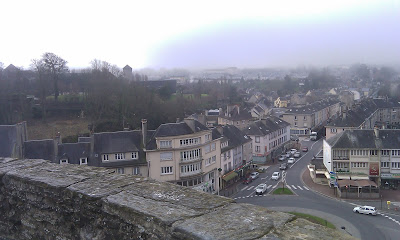We go back in time now to somewhere around 1912. An Englishwoman in Paris has a crush on a pastoral landscape by the early impressionist superstar Jean Baptiste Camille Corot (Kor-OH). It is titled L'Etang, the pond, with woods, water, cows, a guy fishing on the bank. She is Evelyn, she's of an age to have been at the Sorbonne, and, per family legend, a habitue of the art scene. Someone, we don't know who, did her in an exquisite little sketch. She is, however, about to marry.
Her mom, Julia, as a wedding gift for her girl and new husband, is copying the painting onto a bedboard.
She might sketch it and make notes as to the color scheme. She was of a family educated and of an artistic bent likely to frequent Paris, and to to know the piece. London and Paris were, even then, as close as San Francisco and L.A. and people in her class got around. There were renowned actors in the family, and Julia did a pretty accomplished copy of that landscape.
The young couple slept in that bed, lived and died. The bedboard passed down and down again, to an English-born engineer in Canada, thence to his daughter, who befriended me, and one day wondered where the original of that bedboard copy had come to.
I undertook the mission. She sent me photos of the bedboard, I ID'd the painting online, and, tentatively, traced it to a place in the Département de Basse Normandie in France; Le Musée des Beaux-Artes et d'Histoire.
So I went there. Knocked back some Calvados and had a crepe. The museum didn't open until Wednesday afternoon so I spent a day kicking around Saint Lô breathing the northern air.
The docents recognized me from my recon mission the day before and wouldn't let me pay the entrance fee, walked me to the right room. Sure enough, there it was, blam. The real thing. A big feeling. I took some cell phone snaps and caught the train out.
Didn't have to abseil through the skylight into a multibillionaire's mountain fortress, disable the laser-web security system, roll the painting into a tube, evade the vicious dogs and rabid security staff, and rappel down the mountain with a shattered femur and severe frostbite.
What I did do was track the original of a painting through four generations and three countries to bring them together. Or, in a less grandiose mode, download some pics from the web, burn some vacation time on France, email some cell-phone snaps back to Vancouver. Took a ride on a choo-choo train.
Detail, original:
Detail, bedboard:







